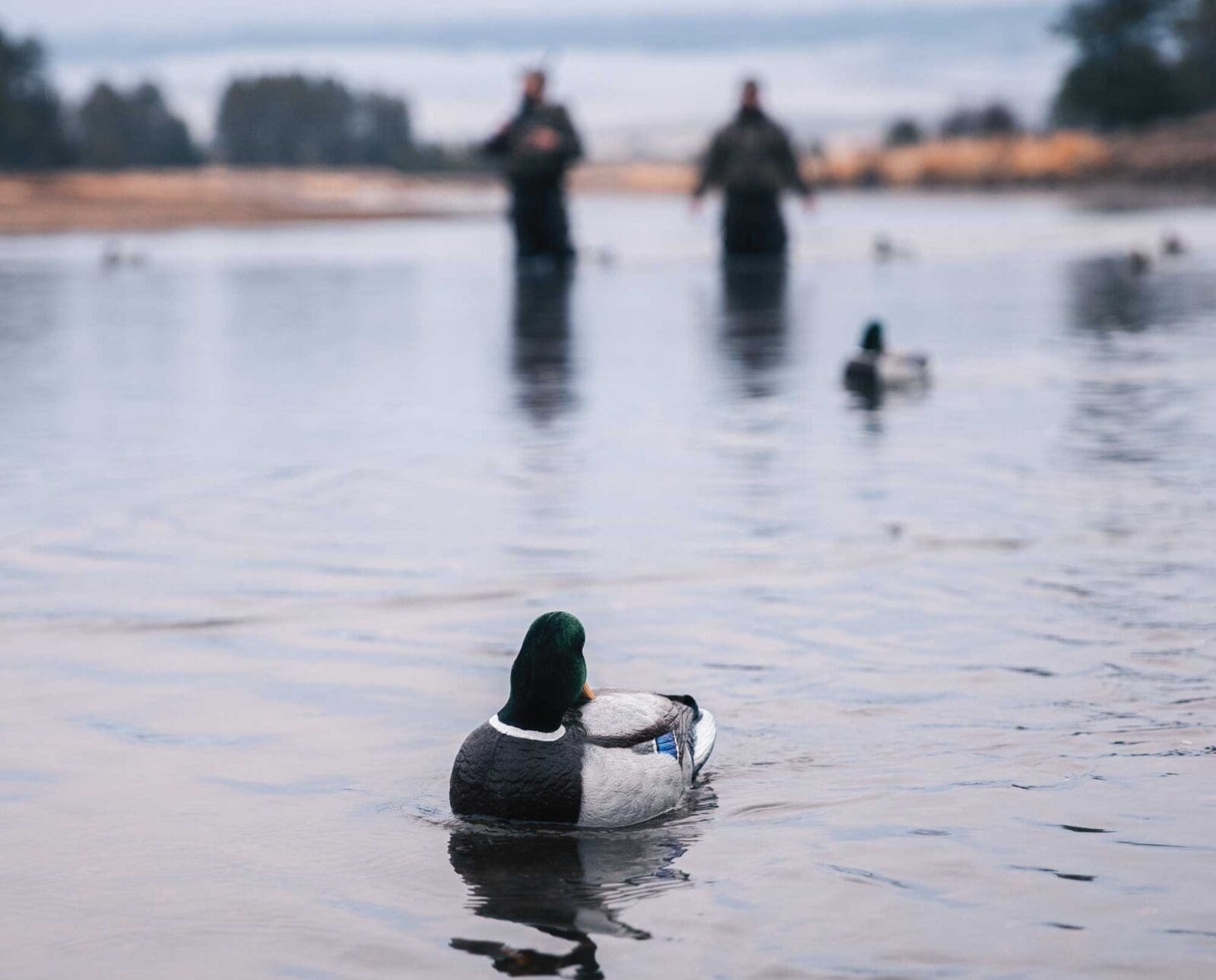Home » Waterfowl Hunting » Perfecting Minimalistic Duck Decoy Setups
Perfecting Minimalistic Duck Decoy Setups

Mike Adams is an outdoor writer, wildlife biologist, and educator…
Simple duck hunting setups is a great way to curb costs and still be successful.
A homemade roll of cordgrass covers my head while I claim my front-row seat on the bay’s edge in my grassed-up kayak. The boat is lodged into a drainage ditch. The front is held in place by my oar, which I drove into the mud at an angle. This kept me from floating out into the cove. From my perspective, it’s hard to differentiate between foaming whitecaps and bobbing buffleheads; the bay seems pocked with both. The small, black ducks fly by in pairs or small flocks, their ivory heads gleaming in the sun. Their shooting opportunities have been endless, but I’m not here for them. I’m here for the pintail and wigeon.
Northern pintails and American wigeons find sanctuary from winter winds and careless duck hunters in this cove every late season. One doesn’t need much to experience a good hunt here. A hand-me-down duck call, a roll of homemade cordgrass, and a few decoys can go a long way if you know how to use them.
I haven’t come up with a name for it yet, but over the years, I’ve developed a style of duck hunting that employs no more than the bare bones. As simple as it sounds, my style is strictly dictated by strategy, and it’s more like perfecting minimalism. Minimalist duck hunting strategies cater to waterfowlers on a budget and appease unnecessary anxieties. This style can be broken down into a few basic tenants: Call less, but learn to make it perfect; hunt over small spreads, but make them right; don’t overthink your camouflage, but don’t settle for anything less than what’s efficient. When done right, perfecting minimalism can be potent in nearly any duck hunting situation.
Make Fewer Duck Calls
Mallards don’t frequent the cove much. They tend to hang up near the woodline with the black ducks and teal. Out in the cove, it’s a whistling bird’s game, and that’s why I left my double reed call at home. Instead, I have a whistle that can be manipulated to sound like the single-tone call of a drake teal, the three-note whistle of a wigeon, or the rolling train whistle of a pintail. Right now, the whistle is tucked in my pocket. When birds fly by, it stays there. But when a pair of wigeon circle my decoys and peel off for the other side of the bay, I pull it out. I ring off a quiet and quick wigeon melody consisting of four wigeon calls in succession and then let the call hang dead on its lanyard. Those birds peel back for another look, and just as they begin to cup their wings, I hear them whistling back.
Duck calling has broken more hunts than it’s made. It’s simply too enticing. Duck hunters feel empowered behind a duck call like they have the power to persuade hesitant birds right where they want them. According to my nameless minimalist hunting strategy, the problem is that’s not what duck calls are made for. Duck calls are made to add confidence to your decoy spread. Calling tells ducks already interested in your decoys that they are real. Duck calls rarely persuade birds; they don’t work well in sparking initial interest. The temptation is always there, and we’ve all found ourselves in situations where we wail into our call incessantly and wait for some magic to happen, but it never does. Overcalling, especially in the late season, often scares birds.
Pick the right duck call for the species you’re hunting, and when it comes time to use it, call sparingly.
Use Small Duck Decoy Spreads
White down feathers swung back and forth as they sank through the air and landed gently on the water; nothing but feathers on that first go around. That pair of wigeon committed to my decoys, but they committed on the edge of my shooting range. Had they landed toward the center of my spread, maybe I’d have two birds laying belly up on the deck of my kayak.
I looked at my setup. There are twelve pintails and twelve wigeons. The pintails are separated into male and female pairs on the upwind side, and the wad of wigeon flank the downwind side. I don’t like to sit still when things fail, so I paddled out to my decoys and culled twelve decoys from the spread: six pintails and six wigeons. I kept the pintail in their male-female pairs and similarly arranged the wigeon. Back at my hunting ditch, I examined my spread again. It was small, but it was natural.
As duck season ticked away, my decoy spreads got progressively smaller. During the early season, we can get away with large numbers of decoys because the ducks are forgiving. They’re willing to overlook unnatural arrangements and the spinning wing decoys that look out of place. After they get shot at a few times, however, they’re no longer willing to forgive.
Late-season spreads need to be precise, so I cut my spread sizes down by December. Then, I autoregulate. When my decoy spread isn’t doing the trick, I give it a look. How can I make it look more natural? Are the species right? How does the arrangement look compared to real birds on the water? Can I remove some decoys? Oddly, if you change one or more of these things, you’ll increase your setup’s effectiveness, and sometimes that’s all you need to draw birds in close.
Use Simple Camouflage When Duck Hunting
A quiet hour goes by after I rearranged my decoys. The sun crept high in the sky, and it was beginning to cast my shadow. I’ve been here since the pre-dawn dark, and all I’d got to show for it thus far were those two shots at the wigeon. I began to count the bobbing buffleheads on the bay. Six, ten, fifteen, and I was up to thirty when I heard whistling wings cutting through the salty air. My eyes strained to the corner of my periphery and peered between the blades of cordgrass. Brown heads, porcelain bellies, and long, black tails contrasted against the blue sky.
I fumbled for my gun as the pintail blasted out overhead. They came in low and fast and swung around just past my decoys. Their chests peeled back, and their wings flapped against the wind when they came to a dead stop just above the center of my decoys. Then, they smacked the water with a splash. That’s when I gained control of the gun. Their heads perked up high like periscopes, and they busted for the air. I pressed the butt of my shotgun to my shoulder and aimed.
It’s simple; good camouflage puts hunters in a position to decoy ducks. If weary ducks can see a hunter, they won’t land. If the setup convinces wary ducks, and they can’t see the hunter, odds are, they will land.
The proper camouflage selection is all about shade and texture. Today, I’m wrapped in a cordgrass robe. Cordgrass growing out of the muck flanks my kayak. Cordgrass fringes the cove against the water. Cordgrass covers the marsh along the banks of the bay. That’s why I’m using cordgrass. If I were hunting wood ducks in a lake brimmed with willows, I’d be wearing a willow robe. If I were hunting black ducks on the upland marsh where salt hay dominates, I’d be covered in salt hay. I’ve seen hunters bring sticks to the marsh and the marsh to the sticks. We can spot a muskrat hut from a mile away because it’s a mound of mixed vegetation surrounded by a mono-crop of some other dominant vegetation. Keep it simple; avoid looking like a muskrat mound by mimicking the dominant vegetation you hunt in.
Putting It All Together
I pluck the pintail from the water by its charcoal foot and hoist it to the deck of my kayak. Briny drops of saltwater roll down its silky belly, and its chocolate-brown head shines in the afternoon sunlight. One pintail made this hunt feel great, so I tucked the bird into my hunting jacket and rolled up my cordgrass blanket. As I picked up the decoys, a few buffleheads buzzed in low and swung around my kayak before taking off for the center of the bay. I watch them glide along the water and disappear into the whitecaps. I wonder how many there were and if they landed with others. I decide I’ll come out the next day and find out.
My favorite thing about duck hunting is the joy it brings me. Every time I try to overcomplicate it, I dilute that joy. That’s why I strive to perfect minimalism, keeping the gear, gizmos, and gadgets to a minimum and keeping the quality of the hunt at its peak. When it comes to creating great hunts, it really is that simple.
Mike Adams is an outdoor writer, wildlife biologist, and educator hailing from salt marshes of the mid-Atlantic. His work has appeared in numerous outdoor publications, where he uses hunting and fishing narratives to explore deeper issues in conservation or ecology. In the fall, you'll find him on his Barnegat Bay Sneakbox hunting ducks with his dog, Boone. Any other time of year, he's usually out on the salt marsh, catching crabs or fishing for striper.




Like your situation awareness. I do think if we are hunting where there are many birds, they will come to a few decoys. I hunted freeze out lake Montana with five decoys in a small pothole by just squatting in the marsh grass. I killed a limit of mallards as simple as could be. It didn’t hurt that these ducks didn’t get any hunting pressure in the lake. People don’t seem to hunt ducks, mostly big game. Also this was 1970.